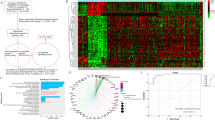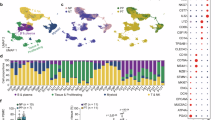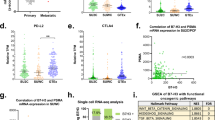Abstract
In this investigation, we explored the molecular dynamics guiding the progression of castration-resistant prostate cancer (CRPC) influenced by Helicobacter pylori (H. pylori)-mediated M2 polarization of macrophages through the IL-17RA/CTSK/EMT axis. An 830-patient clinical trial categorized subjects into hormone-sensitive prostate cancer (HSPC) and CRPC groups. H. pylori infection, evaluated by ELISA, exhibited a higher incidence in CRPC patients, impacting overall survival (OS) and progression-free survival. In-depth in vitro and in vivo experiments, including 16S rDNA sequencing, immunohistochemical tests, and transcriptome analysis, unveiled that H. pylori promotes CRPC growth and metastasis by upregulating IL-17RA and CTSK, leading to enhanced EMT. Notably, M2 macrophages emerged as pivotal immune cells influencing CRPC progression. This study uncovers a novel pathway wherein H. pylori enrichment exacerbates CRPC by inducing macrophage M2 polarization, IL-17RA/CTSK expression, and EMT activation, shedding light on a previously unrecognized mechanism contributing to the growth and metastasis of CRPC.
This is a preview of subscription content, access via your institution
Access options
Subscribe to this journal
Receive 50 print issues and online access
$259.00 per year
only $5.18 per issue
Buy this article
- Purchase on SpringerLink
- Instant access to full article PDF
Prices may be subject to local taxes which are calculated during checkout









Similar content being viewed by others
Data availability
The data that supports the findings of this study are available on request from the corresponding author.
References
Lin W, Li C, Xu N, Watanabe M, Xue R, Xu A, et al. Dual-functional PLGA nanoparticles co-loaded with indocyanine green and resiquimod for prostate cancer treatment. Int J Nanomedicine. 2021;16:2775–87. https://doi.org/10.2147/IJN.S301552.
van Die MD, Williams SG, Emery J, Bone KM, Taylor JM, Lusk E, et al. A placebo-controlled double-blinded randomized pilot study of combination phytotherapy in biochemically recurrent prostate cancer. Prostate. 2017;77:765–75. https://doi.org/10.1002/pros.23317.
Wallis CJD, Klaassen Z, Bhindi B, Goldberg H, Chandrasekar T, Farrell A, et al. Comparison of abiraterone acetate and docetaxel with androgen deprivation therapy in high-risk and metastatic hormone-naïve prostate cancer: a systematic review and network meta-analysis. Eur Urol. 2018;73:834–44. https://doi.org/10.1016/j.eururo.2017.10.002
Desai K, McManus JM, Sharifi N. Hormonal therapy for prostate cancer. Endocr Rev. 2021;42:354–73. https://doi.org/10.1210/endrev/bnab002
McDonald J, O’Brien J, Kostos L, Lawrentschuk N, Azad AA, Murphy D, et al. Systemic therapy in metastatic hormone-sensitive prostate cancer. Curr Opin Support Palliat Care. 2022;16:234–9. https://doi.org/10.1097/SPC.0000000000000622
Saunders PTK, Horne AW. Endometriosis: Etiology, pathobiology, and therapeutic prospects. Cell. 2021;184:2807–24. https://doi.org/10.1016/j.cell.2021.04.041
Devos G, Devlies W, De Meerleer G, Baldewijns M, Gevaert T, Moris L, et al. Neoadjuvant hormonal therapy before radical prostatectomy in high-risk prostate cancer. Nat Rev Urol. 2021;18:739–62. https://doi.org/10.1038/s41585-021-00514-9
Shafi AA, Yen AE, Weigel NL. Androgen receptors in hormone-dependent and castration-resistant prostate cancer. Pharmacol Ther. 2013;140:223–38. https://doi.org/10.1016/j.pharmthera.2013.07.003
Guo C, Figueiredo I, Gurel B, Neeb A, Seed G, Crespo M, et al. B7-H3 as a therapeutic target in advanced prostate cancer [published correction appears in Eur Urol. Eur Urol. 2023;83:224–38. https://doi.org/10.1016/j.eururo.2022.09.004. 2023 Jun;83(6):e168-e169. https://doi.org/10.1016/j.eururo.2023.03.005].
Chandrasekar T, Yang JC, Gao AC, Evans CP. Mechanisms of resistance in castration-resistant prostate cancer (CRPC). Transl Androl Urol. 2015;4:365–80. https://doi.org/10.3978/j.issn.2223-4683.2015.05.02
Makridakis NM, di Salle E, Reichardt JK. Biochemical and pharmacogenetic dissection of human steroid 5 alpha-reductase type II. Pharmacogenetics. 2000;10:407–13. https://doi.org/10.1097/00008571-200007000-00004
Scariano JK, Treat E, Alba F, Nelson H, Ness SA, Smith AY. The SRD5A2 V89L polymorphism is associated with severity of disease in men with early onset prostate cancer. Prostate. 2008;68:1798–805. https://doi.org/10.1002/pros.20842
Sack JS, Kish KF, Wang C, Attar RM, Kiefer SE, An Y, et al. Crystallographic structures of the ligand-binding domains of the androgen receptor and its T877A mutant complexed with the natural agonist dihydrotestosterone. Proc Natl Acad Sci USA. 2001;98:4904–9. https://doi.org/10.1073/pnas.081565498
Suzuki H, Akakura K, Komiya A, Aida S, Akimoto S, Shimazaki J. Codon 877 mutation in the androgen receptor gene in advanced prostate cancer: relation to antiandrogen withdrawal syndrome. Prostate. 1996;29:153–8. https://doi.org/10.1002/1097-0045(199609)29:33.0.co;2-5
van de Wijngaart DJ, Molier M, Lusher SJ, Hersmus R, Jenster G, Trapman J, et al. Systematic structure-function analysis of androgen receptor Leu701 mutants explains the properties of the prostate cancer mutant L701H. J Biol Chem. 2010;285:5097–105. https://doi.org/10.1074/jbc.M109.039958
Thompson J, Saatcioglu F, Jänne OA, Palvimo JJ. Disrupted amino- and carboxyl-terminal interactions of the androgen receptor are linked to androgen insensitivity. Mol Endocrinol. 2001;15:923–35. https://doi.org/10.1210/mend.15.6.0647
Hara T, Kouno J, Nakamura K, Kusaka M, Yamaoka M. Possible role of adaptive mutation in resistance to antiandrogen in prostate cancer cells. Prostate. 2005;65:268–75. https://doi.org/10.1002/pros.20282
Ni L, Yang CS, Gioeli D, Frierson H, Toft DO, Paschal BM. FKBP51 promotes assembly of the Hsp90 chaperone complex and regulates androgen receptor signaling in prostate cancer cells. Mol Cell Biol. 2010;30:1243–53. https://doi.org/10.1128/MCB.01891-08
Ueda T, Mawji NR, Bruchovsky N, Sadar MD. Ligand-independent activation of the androgen receptor by interleukin-6 and the role of steroid receptor coactivator-1 in prostate cancer cells. J Biol Chem. 2002;277:38087–94. https://doi.org/10.1074/jbc.M203313200
Debes JD, Schmidt LJ, Huang H, Tindall DJ. p300 mediates androgen-independent transactivation of the androgen receptor by interleukin 6. Cancer Res. 2002;62:5632–6.
Nadiminty N, Lou W, Lee SO, Lin X, Trump DL, Gao AC. Stat3 activation of NF-{kappa}B p100 processing involves CBP/p300-mediated acetylation. Proc Natl Acad Sci USA. 2006;103:7264–9. https://doi.org/10.1073/pnas.0509808103
Nadiminty N, Tummala R, Liu C, Yang J, Lou W, Evans CP, et al. NF-κB2/p52 induces resistance to enzalutamide in prostate cancer: role of androgen receptor and its variants. Mol Cancer Ther. 2013;12:1629–37. https://doi.org/10.1158/1535-7163.MCT-13-0027
Jiang X, Chen S, Asara JM, Balk SP. Phosphoinositide 3-kinase pathway activation in phosphate and tensin homolog (PTEN)-deficient prostate cancer cells is independent of receptor tyrosine kinases and mediated by the p110beta and p110delta catalytic subunits. J Biol Chem. 2010;285:14980–9. https://doi.org/10.1074/jbc.M109.085696
Xu P, Wasielewski LJ, Yang JC, Cai D, Evans CP, Murphy WJ, et al. The immunotherapy and immunosuppressive signaling in therapy-resistant prostate cancer. Biomedicines. 2022;10:1778 https://doi.org/10.3390/biomedicines10081778.
Nagireddy S, Qureshi R, Best J, Frech FS, Shah K, Soni Y, et al. Current treatment modalities targeting tumor microenvironment in castration-resistant prostate cancer. Adv Exp Med Biol. 2021;1329:295–323. https://doi.org/10.1007/978-3-030-73119-9_16
Wang F, Liu S, Liu F, Xu T, Ma J, Liang J, et al. TIGIT immune checkpoint blockade enhances immunity of human peripheral blood NK cells against castration-resistant prostate cancer. Cancer Lett. 2023;568:216300 https://doi.org/10.1016/j.canlet.2023.216300
Calcinotto A, Spataro C, Zagato E, Di Mitri D, Gil V, Crespo M, et al. IL-23 secreted by myeloid cells drives castration-resistant prostate cancer. Nature. 2018;559:363–9. https://doi.org/10.1038/s41586-018-0266-0
Li XF, Selli C, Zhou HL, Cao J, Wu S, Ma RY, et al. Macrophages promote anti-androgen resistance in prostate cancer bone disease. J Exp Med. 2023;220:e20221007 https://doi.org/10.1084/jem.20221007
Li S, Kang Y, Zeng Y. Targeting tumor and bone microenvironment: Novel therapeutic opportunities for castration-resistant prostate cancer patients with bone metastasis. Biochim Biophys Acta Rev Cancer. 2024;1879:189033 https://doi.org/10.1016/j.bbcan.2023.189033
Alvarez-Arzola R, Bancaro N, Lai P, Attanasio G, Pellegrini L, Troiani M, et al. VSSP-activated macrophages mediate senescence and tumor inhibition in a preclinical model of advanced prostate cancer. Cell Commun Signal. 2023;21:76 https://doi.org/10.1186/s12964-023-01095-3.
Sullivan C, Brown NE, Vasiliauskas J, Pathrose P, Starnes SL, Waltz SE. Prostate epithelial RON signaling promotes M2 macrophage activation to drive prostate tumor growth and progression. Mol Cancer Res. 2020;18:1244–54. https://doi.org/10.1158/1541-7786.MCR-20-0060
Brown NE, Jones A, Hunt BG, Waltz SE. Prostate tumor RON receptor signaling mediates macrophage recruitment to drive androgen deprivation therapy resistance through Gas6-mediated Axl and RON signaling. Prostate. 2022;82:1422–37. https://doi.org/10.1002/pros.24416
Garbas K, Zapała P, Zapała Ł, Radziszewski P. The role of microbial factors in prostate cancer development-an up-to-date review. J Clin Med. 2021;10:4772 https://doi.org/10.3390/jcm10204772.
Ribarska T, Goering W, Droop J, Bastian KM, Ingenwerth M, Schulz WA. Deregulation of an imprinted gene network in prostate cancer. Epigenetics. 2014;9:704–17. https://doi.org/10.4161/epi.28006
Pernigoni N, Zagato E, Calcinotto A, Troiani M, Mestre RP, Calì B, et al. Commensal bacteria promote endocrine resistance in prostate cancer through androgen biosynthesis. Science. 2021;374:216–24. https://doi.org/10.1126/science.abf8403
Li R, Zhou R, Wang H, Li W, Pan M, Yao X, et al. Gut microbiota-stimulated cathepsin K secretion mediates TLR4-dependent M2 macrophage polarization and promotes tumor metastasis in colorectal cancer. Cell Death Differ. 2019;26:2447–63. https://doi.org/10.1038/s41418-019-0312-y
Wu N, Wang Y, Wang K, Zhong B, Liao Y, Liang J, et al. Cathepsin K regulates the tumor growth and metastasis by IL-17/CTSK/EMT axis and mediates M2 macrophage polarization in castration-resistant prostate cancer. Cell Death Dis. 2022;13:813 https://doi.org/10.1038/s41419-022-05215-8. Published 2022 Sep 22
Aiello NM, Kang Y. Context-dependent EMT programs in cancer metastasis. J Exp Med. 2019;216:1016–26. https://doi.org/10.1084/jem.20181827
Yang C, Dou R, Wei C, Liu K, Shi D, Zhang C, et al. Tumor-derived exosomal microRNA-106b-5p activates EMT-cancer cell and M2-subtype TAM interaction to facilitate CRC metastasis. Mol Ther. 2021;29:2088–107. https://doi.org/10.1016/j.ymthe.2021.02.006
Huang Y, Hong W, Wei X. The molecular mechanisms and therapeutic strategies of EMT in tumor progression and metastasis. J Hematol Oncol. 2022;15:129 https://doi.org/10.1186/s13045-022-01347-8.
Yang X, Guo Y, Chen C, Shao B, Zhao L, Zhou Q, et al. Interaction between intestinal microbiota and tumour immunity in the tumour microenvironment. Immunology. 2021;164:476–93. https://doi.org/10.1111/imm.13397
Hanus M, Parada-Venegas D, Landskron G, Wielandt AM, Hurtado C, Alvarez K, et al. Immune system, microbiota, and microbial metabolites: the unresolved triad in colorectal cancer microenvironment. Front Immunol. 2021;12:612826 https://doi.org/10.3389/fimmu.2021.612826.
Cai J, Sun L, Gonzalez FJ. Gut microbiota-derived bile acids in intestinal immunity, inflammation, and tumorigenesis. Cell Host Microbe. 2022;30:289–300. https://doi.org/10.1016/j.chom.2022.02.004
Lu Y, Yuan X, Wang M, He Z, Li H, Wang J, et al. Gut microbiota influence immunotherapy responses: mechanisms and therapeutic strategies. J Hematol Oncol. 2022;15:47 https://doi.org/10.1186/s13045-022-01273-9.
Qiu Q, Lin Y, Ma Y, Li X, Liang J, Chen Z, et al. Exploring the emerging role of the gut microbiota and tumor microenvironment in cancer immunotherapy. Front Immunol. 2021;11:612202 https://doi.org/10.3389/fimmu.2020.612202.
Hinshaw DC, Shevde LA. The tumor microenvironment innately modulates cancer progression. Cancer Res. 2019;79:4557–66. https://doi.org/10.1158/0008-5472.CAN-18-3962
Qin JF, Jin FJ, Li N, Guan HT, Lan L, Ni H, et al. Adrenergic receptor β2 activation by stress promotes breast cancer progression through macrophages M2 polarization in tumor microenvironment. BMB Rep. 2015;48:295–300. https://doi.org/10.5483/bmbrep.2015.48.5.008
Jayasingam SD, Citartan M, Thang TH, Mat Zin AA, Ang KC, Ch’ng ES. Evaluating the polarization of tumor-associated macrophages Into M1 and M2 phenotypes in human cancer tissue: technicalities and challenges in routine clinical practice. Front Oncol. 2020;9:1512 https://doi.org/10.3389/fonc.2019.01512.
Schreiber RD, Old LJ, Smyth MJ. Cancer immunoediting: integrating immunity’s roles in cancer suppression and promotion. Science. 2011;331:1565–70. https://doi.org/10.1126/science.1203486
Appelmelk BJ, Simoons-Smit I, Negrini R, Moran AP, Aspinall GO, Forte JG, et al. Potential role of molecular mimicry between Helicobacter pylori lipopolysaccharide and host Lewis blood group antigens in autoimmunity. Infect Immun. 1996;64:2031–40. https://doi.org/10.1128/iai.64.6.2031-2040.1996
Ko GH, Park HB, Shin MK, Park CK, Lee JH, Youn HS, et al. Monoclonal antibodies against Helicobacter pylori cross-react with human tissue. Helicobacter. 1997;2:210–5. https://doi.org/10.1111/j.1523-5378.1997.tb00090.x
Markle JG, Frank DN, Mortin-Toth S, Robertson CE, Feazel LM, Rolle-Kampczyk U, et al. Sex differences in the gut microbiome drive hormone-dependent regulation of autoimmunity. Science. 2013;339:1084–8. https://doi.org/10.1126/science.1233521
Schooling CM, Dowd JB, Jones HE. Helicobacter pylori is associated with lower androgen activity among men in NHANES III. Gut. 2013;62:1384–5. https://doi.org/10.1136/gutjnl-2013-304891
Liu JM, Wu CT, Hsu RJ, Hsu WL. Association between Helicobacter pylori infection and mortality risk in prostate cancer patients receiving androgen deprivation therapy: A real-world evidence study. Cancer Med. 2021;10:8162–71. https://doi.org/10.1002/cam4.4318
Shrestha E, White JR, Yu SH, Kulac I, Ertunc O, De Marzo AM, et al. Profiling the urinary microbiome in men with positive versus negative biopsies for prostate cancer. J Urol. 2018;199:161–71. https://doi.org/10.1016/j.juro.2017.08.001
Tie Y, Tang F, Wei YQ, Wei XW. Immunosuppressive cells in cancer: mechanisms and potential therapeutic targets. J Hematol Oncol. 2022;15:61 https://doi.org/10.1186/s13045-022-01282-8.
Yang T, Wang R, Liu H. Berberine regulates macrophage polarization through IL-4-STAT6 signaling pathway in Helicobacter pylori-induced chronic atrophic gastritis. Life Sci. 2021;266:118903 https://doi.org/10.1016/j.lfs.2020.118903
Triana-Martínez F, Loza MI, Domínguez E. Beyond tumor suppression: senescence in cancer stemness and tumor dormancy. Cells. 2020;9:346 https://doi.org/10.3390/cells9020346.
Wang YL, Sheu BS, Huang JJ, Yang HB. Noninvasive stool antigen assay can effectively screen Helicobacter pylori Infection and assess success of eradication therapy in hemodialysis patients. Am J Kidney Dis. 2001;38:98–103. https://doi.org/10.1053/ajkd.2001.25200
Chi KN, Chowdhury S, Bjartell A, Chung BH, Pereira de Santana Gomes AJ, Given R, et al. Apalutamide in patients with metastatic castration-sensitive prostate cancer: final survival analysis of the randomized, double-blind, phase III TITAN study. J Clin Oncol. 2021;39:2294–303. https://doi.org/10.1200/JCO.20.03488
Lange T, Ullrich S, Müller I, Nentwich MF, Stübke K, Feldhaus S, et al. Human prostate cancer in a clinically relevant xenograft mouse model: identification of β(1,6)-branched oligosaccharides as a marker of tumor progression. Clin Cancer Res. 2012;18:1364–73. https://doi.org/10.1158/1078-0432.CCR-11-2900
De Velasco MA, Tanaka M, Yamamoto Y, Hatanaka Y, Koike H, Nishio K, et al. Androgen deprivation induces phenotypic plasticity and promotes resistance to molecular targeted therapy in a PTEN-deficient mouse model of prostate cancer. Carcinogenesis. 2014;35:2142–53. https://doi.org/10.1093/carcin/bgu143
Allott EH, Masko EM, Freedland AR, Macias E, Pelton K, Solomon KR, et al. Serum cholesterol levels and tumor growth in a PTEN-null transgenic mouse model of prostate cancer. Prostate Cancer Prostatic Dis. 2018;21:196–203. https://doi.org/10.1038/s41391-018-0045-x
Wang Y, Yuan Y, Wang W, He Y, Zhong H, Zhou X, et al. Mechanisms underlying the therapeutic effects of Qingfeiyin in treating acute lung injury based on GEO datasets, network pharmacology and molecular docking. Comput Biol Med. 2022;145:105454 https://doi.org/10.1016/j.compbiomed.2022.105454
Yu G, Wang LG, Han Y, He QY. clusterProfiler: an R package for comparing biological themes among gene clusters. OMICS. 2012;16:284–7. https://doi.org/10.1089/omi.2011.0118
Lu X, Xuan W, Li J, Yao H, Huang C, Li J. AMPK protects against alcohol-induced liver injury through UQCRC2 to up-regulate mitophagy. Autophagy. 2021;17:3622–43. https://doi.org/10.1080/15548627.2021.1886829
Zou S, Wang C, Cui Z, Guo P, Meng Q, Shi X, et al. β-Elemene induces apoptosis of human rheumatoid arthritis fibroblast-like synoviocytes via reactive oxygen species-dependent activation of p38 mitogen-activated protein kinase. Pharmacol Rep. 2016;68:7–11. https://doi.org/10.1016/j.pharep.2015.06.004
Newman AM, Liu CL, Green MR. Robust enumeration of cell subsets from tissue expression profiles. Nat Methods. 2015;12:453–7. https://doi.org/10.1038/nmeth.3337
Ali HR, Chlon L, Pharoah PD, Markowetz F, Caldas C. Patterns of immune infiltration in breast cancer and their clinical implications: a gene-expression-based retrospective study. PLoS Med. 2016;13:e1002194 https://doi.org/10.1371/journal.pmed.1002194.
Xu C, Fan L, Lin Y, Shen W, Qi Y, Zhang Y, et al. Fusobacterium nucleatum promotes colorectal cancer metastasis through miR-1322/CCL20 axis and M2 polarization. Gut Microbes. 2021;13:1980347 https://doi.org/10.1080/19490976.2021.1980347
Yang J, Li Y, Zhang Y, Fang X, Chen N, Zhou X, et al. Sirt6 promotes tumorigenesis and drug resistance of diffuse large B-cell lymphoma by mediating PI3K/Akt signaling. J Exp Clin Cancer Res. 2020;39:142 https://doi.org/10.1186/s13046-020-01623-w.
He GN, Bao NR, Wang S, Xi M, Zhang TH, Chen FS. Ketamine induces ferroptosis of liver cancer cells by targeting lncRNA PVT1/miR-214-3p/GPX4. Drug Des Devel Ther. 2021;15:3965–78. https://doi.org/10.2147/DDDT.S332847.
Wei CH, Wu G, Cai Q, Gao XC, Tong F, Zhou R, et al. MicroRNA-330-3p promotes cell invasion and metastasis in non-small cell lung cancer through GRIA3 by activating MAPK/ERK signaling pathway. J Hematol Oncol. 2017;10:125 https://doi.org/10.1186/s13045-017-0493-0. [retracted in: J Hematol Oncol. 2020 Oct 22;13(1):142. https://doi.org/10.1186/s13045-020-00969-0].
Liang N, Li Y, Chung HY. Two natural eudesmane-type sesquiterpenes from Laggera alata inhibit angiogenesis and suppress breast cancer cell migration through VEGF- and Angiopoietin 2-mediated signaling pathways. Int J Oncol. 2017;51:213–22. https://doi.org/10.3892/ijo.2017.4004
Funding
This study was supported by Shanghai Medical Innovation Research Special Foundation (No. 23Y11908800), CSCO-Haosen Oncology Research Fund (No. Y-HS202301-0096) and Shanghai Natural Science Foundation (No. 21ZR1414500).
Author information
Authors and Affiliations
Contributions
GL, FT and QY wrote the paper and conceived and designed the experiments; XW, NY and FZ analyzed the data; CY, JY and DY collected and provided the sample for this study. All authors have read and approved the final submitted manuscript.
Corresponding authors
Ethics declarations
Competing interests
The authors declare no competing interests.
Ethics approval and consent to participate
The Ethics Committee of Fudan University Shanghai Cancer Center approved all research protocols, and the study’s content and objectives were clearly explained to the patients and their families, acquiring their informed consent. We strictly adhered to the Helsinki Declaration guidelines and ensured the anonymization of patient data. The animal experimental processes were approved by the Ethnic Committee of Fudan University Shanghai Cancer Center and in strict accordance with the recommendations of the Guide for the Care and Use of Laboratory Animals published by the US National Institutes of Health (050432-4-1911D). Adequate measures were taken to minimize suffering of the included animals.
Additional information
Publisher’s note Springer Nature remains neutral with regard to jurisdictional claims in published maps and institutional affiliations.
Supplementary information
Rights and permissions
Springer Nature or its licensor (e.g. a society or other partner) holds exclusive rights to this article under a publishing agreement with the author(s) or other rightsholder(s); author self-archiving of the accepted manuscript version of this article is solely governed by the terms of such publishing agreement and applicable law.
About this article
Cite this article
Lin, G., Tian, F., Yu, Q. et al. IL-17RA/CTSK axis mediates H. pylori-induced castration-resistant prostate cancer growth. Oncogene 43, 3598–3616 (2024). https://doi.org/10.1038/s41388-024-03169-z
Received:
Revised:
Accepted:
Published:
Issue date:
DOI: https://doi.org/10.1038/s41388-024-03169-z
This article is cited by
-
Identification of biomarkers associated with mitophagy in bladder cancer
Scientific Reports (2025)



